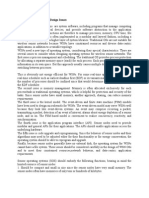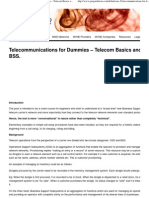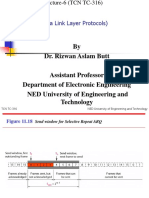Assignment 3 Final
Assignment 3 Final
Uploaded by
Rizwan Aslam ButtCopyright:
Available Formats
Assignment 3 Final
Assignment 3 Final
Uploaded by
Rizwan Aslam ButtOriginal Description:
Copyright
Available Formats
Share this document
Did you find this document useful?
Is this content inappropriate?
Copyright:
Available Formats
Assignment 3 Final
Assignment 3 Final
Uploaded by
Rizwan Aslam ButtCopyright:
Available Formats
Q1. Design and describe an application-level protocol to be used between an Automatic Teller Machine, and a bank's centralized computer.
Your protocol should allow a user's card and password to be verified, the account balance (which is maintained at the centralized computer) to be queried, and an account withdrawal (i.e., when money is given to the user) to be made. Your protocol entities should be able to handle the all-too-common case in which there is not enough money in the account to cover the withdrawal. Specify your protocol by listing the messages exchanged, and the action taken by the Automatic Teller Machine or the bank's centralized computer on transmission and receipt of messages. Sketch the operation of your protocol for the case of a simple withdrawal with no errors, using a diagram similar to that in Figure given below. Explicitly state the assumptions made by your protocol about the underlying end-to-end transport service.
There can be many approaches to this for example one protocol can be as follows in which we can have several pre-defined messages that can be used for the required communication.
Ans.
Messages/Commands from ATM machine to Server ,
Message -------HELO PASWRD BALANCE WITHDRAWL <amount> BYE Msg name -------PASSWD OK ERR AMOUNT Description ------Send the server no of card inserted in ATM. User is asked for PIN and the response is sent to Server. The user requests balance User asks to withdraw money user send terminate signal. purpose ------Ask user for PIN (password) Indication of successful completion of last request. Indicates that the last requested operation (PASSWD or WITHDRAWL) in could not be completed successfully. sent in response to BALANCE request
Messages from Server to ATM machine
BYE
user done, display welcome screen at ATM
Case of a simple withdrawal with no errors
client HELO PASSWD BALANCE WITHDRAWL --------------> <--------------------------> <--------------------------> <-------------------------->
server (check if valid userid) PASSWD (check password) OK (password is OK) AMOUNT <amt> check if enough $ to cover withdrawl OK
<------------ATM initiates BYE--------------> <------------- Server also says BYE
Case when there's not enough money:
HELO (userid) --------------> <------------PASSWD <passwd> --------------> <------------BALANCE --------------> <------------WITHDRAWL <amt> --------------> <------------error msg displayed no $ given out BYE --------------> <------------(check if valid userid) PASSWD (check password) OK (password is OK) AMOUNT <amt> check if enough $ to cover withdrawl ERR (not enough funds)
BYE
Q2. Consider an application which transmits data at a steady rate (e.g., the sender generates a N bit unit of
data every k time units, where k is small and fixed). Also, when such an application starts, it will stay on for relatively long period of time. Answer the following questions, briefly justifying your answer: a. Would a packet-switched network or a circuit-switched network be more appropriate for this application? Why? b. Suppose that a packet-switching network is used and the only traffic in this network comes from such applications as described above. Furthermore, assume that the sum of the application data rates is less that the capacities of each and every link. Is some form of congestion control needed? Why? Ans. a) A circuit-switched network would be well suited to the application described, because the application involves long sessions with predictable smooth bandwidth requirements. Since the transmission rate is known and not bursty , bandwidth can be reserved for each application session circuit with no significant waste. In addition, we dont have to worry greatly about the overhead costs of setting up and tearing down a circuit connection, which are amortized over the lengthy duration of a typical application session.
b) Given such generous link capacities, the network needs no congestion control mechanism. In the worst (most potentially congested) case, all the applications simultaneously transmit over one or more particular network links. However, since each link offers sufficient bandwidth to handle the sum of all of the applications' data rates, no congestion (very little queueing) will occur.
Ans. Guests arrive at home. The host decides to serve with pizza. He orders through telephone. Order clerk takes the order and asks the concerned staff to cook pizza. Now this was the transmission side of signal. Now towards receiving side : the pizza is cooked , order clerk hands over to delivery department who take it for delivery through van and deliver it to the host who ordered it. The host serves it to the guests. Q4. The French and Chinese prime ministers need to come to an agreement by telephone, but neither speaks the others language. Further, neither has on hand a translator that can translate to the language of the other. However, both prime ministers have English translators on their staffs. Draw a diagram similar to diagram given in Q3, above to depict the situation, and describe the interaction at each level. Ans.
French PM
French to English Translator and vice versa
Chinese PM
English to Chinese Translator and vice versa
French PM speaks in French. The translator in his team translates it to English. The message is heard by the English to Chinese translator in other team. He translates it in Chinese which is understood by the Chinese PM. Same process is repeated vice versa. Q5. In continuation to the question given above, now suppose that the Chinese prime ministers translator can translate only into Japanese and that the French prime minister has a German translator available. A translator between German and Japanese is available in Germany. Draw a new diagram that reflects this arrangement and describe the hypothetical phone conversation.
French PM
German to French
Chinese PM
Chinese to Japanese Translator and vice versa. Japanase to Gertman Translator and vice versa.
Translator and vice versa.
You might also like
- Iot Systems Management With Netconf-Yang: by J.Ann Roseela Ap/EceDocument32 pagesIot Systems Management With Netconf-Yang: by J.Ann Roseela Ap/EceRamesh BoseNo ratings yet
- Manual Flare Sim ExproDocument69 pagesManual Flare Sim ExproJuan Pablo Alonso100% (3)
- Online Unused Medicine Donation For NgosDocument5 pagesOnline Unused Medicine Donation For NgosSiddique ShahistaNo ratings yet
- Telecom Basics and Introduction To BSSDocument8 pagesTelecom Basics and Introduction To BSSJustice BaloyiNo ratings yet
- UML Diagrams - AssignmentDocument2 pagesUML Diagrams - AssignmentSushank ShresthaNo ratings yet
- Locating Mobile Entities in Distributed SystemsDocument2 pagesLocating Mobile Entities in Distributed SystemsSri R67% (3)
- Case Study of Various Routing AlgorithmDocument25 pagesCase Study of Various Routing AlgorithmVijendra SolankiNo ratings yet
- Asynchronous (Serial, CommunicationDocument2 pagesAsynchronous (Serial, CommunicationS.Ramesh rajaNo ratings yet
- r05311201 Automata and Compiler DesignDocument6 pagesr05311201 Automata and Compiler DesignSrinivasa Rao G100% (3)
- Compiler Design Chapter-3Document177 pagesCompiler Design Chapter-3Vuggam Venkatesh0% (1)
- System Software and Compiler DesignDocument34 pagesSystem Software and Compiler Designsourabha DNo ratings yet
- Sensor Operating System Design IssuesDocument3 pagesSensor Operating System Design IssuesajaychhotuNo ratings yet
- Program RelocationDocument2 pagesProgram RelocationSagar ChingaliNo ratings yet
- Distributed File System Questions and AnswersDocument6 pagesDistributed File System Questions and Answerscalvingeness71No ratings yet
- CS8603 Distributed SystemsDocument11 pagesCS8603 Distributed SystemsMohammad Bilal - Asst. Prof, Dept. of CSENo ratings yet
- PPL Complete Notes JntuhDocument125 pagesPPL Complete Notes JntuhAngel SweetyNo ratings yet
- Existing SystemDocument3 pagesExisting SystemNikhil Aggarwal0% (1)
- Unit-1 (Cloud Computing) 1. (Accessible) Scalable Computing Over The InternetDocument17 pagesUnit-1 (Cloud Computing) 1. (Accessible) Scalable Computing Over The InternetJigidi JingaNo ratings yet
- Covid19-TMS Report Kings2Document55 pagesCovid19-TMS Report Kings2RockyNo ratings yet
- SDLC - Incremental Vs Evolutionary Software Development Process - NotepubDocument4 pagesSDLC - Incremental Vs Evolutionary Software Development Process - NotepubNote PubNo ratings yet
- DWDMDocument25 pagesDWDMGiriDharanNo ratings yet
- Se4151 - Ase - AnbarasanDocument10 pagesSe4151 - Ase - AnbarasanraviNo ratings yet
- Lab Manual Soft Computing IT - 701Document60 pagesLab Manual Soft Computing IT - 701Devendra Singh KaushalNo ratings yet
- Chapter 3-Part IIDocument26 pagesChapter 3-Part IIAbebaw Gebre100% (1)
- BI Lab ManualDocument9 pagesBI Lab Manualiamhafsa0% (1)
- Programmable Interval Timer - 8254Document27 pagesProgrammable Interval Timer - 8254ShazidNo ratings yet
- Chapter 10: Forouzan Data Communications and NetworksDocument3 pagesChapter 10: Forouzan Data Communications and NetworksMaithaNo ratings yet
- PK Sinha Distributed Operating System PDFDocument4 pagesPK Sinha Distributed Operating System PDFJivesh Garg0% (1)
- Ai Important Questions For Semester ExamsDocument197 pagesAi Important Questions For Semester ExamsDeepak YaduvanshiNo ratings yet
- Network Programming Unit I NotesDocument20 pagesNetwork Programming Unit I NotesS Sagar0% (1)
- Issues in Knowledge AcquisitionDocument8 pagesIssues in Knowledge AcquisitionVishal Mohan GoyalNo ratings yet
- III CSE Lab Manual-OoadDocument55 pagesIII CSE Lab Manual-OoadBharath kumarNo ratings yet
- Cloud Computing Unit-I JNTUH R16Document31 pagesCloud Computing Unit-I JNTUH R16vizier100% (1)
- Chapter Seven Multimedia Data Compression 1. Lossy and Lossless CompressionDocument34 pagesChapter Seven Multimedia Data Compression 1. Lossy and Lossless CompressionGemechu Ayana100% (1)
- Os PPT-1Document12 pagesOs PPT-1Dhanush MudigereNo ratings yet
- CS2060 High Speed Networks Lecture Notes Unit I To VDocument94 pagesCS2060 High Speed Networks Lecture Notes Unit I To VkanjaiNo ratings yet
- Lab Manual For VTU MTECH in MANETDocument40 pagesLab Manual For VTU MTECH in MANETHaffnerNo ratings yet
- Unit 2 Ooad 2020 PptcompleteDocument96 pagesUnit 2 Ooad 2020 PptcompleteLAVANYA KARTHIKEYANNo ratings yet
- Chapter 3 - Pipelining-And-Vector-ProcessingDocument29 pagesChapter 3 - Pipelining-And-Vector-Processingtkavitha100% (1)
- Synopsis of Blood Bank Management SystemDocument29 pagesSynopsis of Blood Bank Management SystemSaurabh MatheNo ratings yet
- Cooperative Process: Prepared & Presented By: Abdul Rehman & Muddassar AliDocument18 pagesCooperative Process: Prepared & Presented By: Abdul Rehman & Muddassar AliSeño RitaNo ratings yet
- OSAssignment K1508Document15 pagesOSAssignment K1508Happy0% (1)
- SeminarDocument20 pagesSeminarAbhishek Agarwal100% (2)
- OS ServicesDocument6 pagesOS ServicesAnil KumarNo ratings yet
- A File System For Mobile ComputingDocument28 pagesA File System For Mobile ComputingHemant TulsaniNo ratings yet
- Answer: A: Department of Information Technology UNIT-II-CAO-MCQ B.Tech 4 SEMDocument4 pagesAnswer: A: Department of Information Technology UNIT-II-CAO-MCQ B.Tech 4 SEMVaishNo ratings yet
- Data Dissemination and Synchronization: Communications Asymmetry, Classification of DataDocument29 pagesData Dissemination and Synchronization: Communications Asymmetry, Classification of DataHarish SarkiNo ratings yet
- DAA Unit 5Document14 pagesDAA Unit 5hari karanNo ratings yet
- 2-1-Features of Cloud and Grid PlatformsDocument3 pages2-1-Features of Cloud and Grid PlatformsJathin Darsi100% (1)
- Tutorial Week 2: 1. What Are The Characteristics of A Mobile Computing Environment?Document5 pagesTutorial Week 2: 1. What Are The Characteristics of A Mobile Computing Environment?saneel kumarNo ratings yet
- 02 Data Mining-Partitioning MethodDocument8 pages02 Data Mining-Partitioning MethodRaj EndranNo ratings yet
- Types of Communication: Persistent Versus Transient Synchronous Versus Asynchronous Discrete Versus StreamingDocument32 pagesTypes of Communication: Persistent Versus Transient Synchronous Versus Asynchronous Discrete Versus StreamingDr-Mahmoud AljawarnehNo ratings yet
- Ip NotesDocument74 pagesIp NotesMunavalli Matt K S100% (5)
- Compiler Design NotesDocument8 pagesCompiler Design NotesiritikdevNo ratings yet
- Rapid Application Development A Complete Guide - 2019 EditionFrom EverandRapid Application Development A Complete Guide - 2019 EditionNo ratings yet
- Advanced Computer Networks - DR ArshadDocument3 pagesAdvanced Computer Networks - DR ArshadIqbal Uddin KhanNo ratings yet
- Prepaid MVNO - Telecom Basics and Introduction To BSSDocument14 pagesPrepaid MVNO - Telecom Basics and Introduction To BSSariful_islam_20067643No ratings yet
- Transport Layer: Fig. 6-4 Nesting of TPDU's, Packets, and FramesDocument22 pagesTransport Layer: Fig. 6-4 Nesting of TPDU's, Packets, and FramesAnantharaj ManojNo ratings yet
- Computer Networks (CS425) : Unix Socket Programming (Contd..)Document6 pagesComputer Networks (CS425) : Unix Socket Programming (Contd..)Anish VeettiyankalNo ratings yet
- 2 Traffic TheoryDocument25 pages2 Traffic TheoryFuzail A. SiddiquiNo ratings yet
- Assignment 2Document1 pageAssignment 2MarvinNo ratings yet
- TCN Lec-5Document63 pagesTCN Lec-5Rizwan Aslam ButtNo ratings yet
- TCN Lec-2 - UpdatedDocument46 pagesTCN Lec-2 - UpdatedRizwan Aslam ButtNo ratings yet
- TCN Lec-6Document43 pagesTCN Lec-6Rizwan Aslam ButtNo ratings yet
- TCN Lec-4Document36 pagesTCN Lec-4Rizwan Aslam ButtNo ratings yet
- Optical Fiber Technology: A Novel Smooth PON Evolution Based On Signal CancellationDocument8 pagesOptical Fiber Technology: A Novel Smooth PON Evolution Based On Signal CancellationRizwan Aslam ButtNo ratings yet
- TCN Lec-7Document39 pagesTCN Lec-7Rizwan Aslam ButtNo ratings yet
- Recommendation LetterDocument1 pageRecommendation LetterRizwan Aslam ButtNo ratings yet
- A Highly Flexible and Efficient Passive Optical Network Employing Dynamic Wavelength AllocationDocument10 pagesA Highly Flexible and Efficient Passive Optical Network Employing Dynamic Wavelength AllocationRizwan Aslam ButtNo ratings yet
- Role of Icao, Iata and Aci in AvsecDocument11 pagesRole of Icao, Iata and Aci in AvsecRizwan Aslam Butt100% (1)
- Intensity Transformations & Spatial FilteringDocument49 pagesIntensity Transformations & Spatial FilteringRizwan Aslam ButtNo ratings yet
- Bca 2021Document122 pagesBca 2021harmeetNo ratings yet
- Eagle Point PresentationDocument91 pagesEagle Point PresentationRazi Baig100% (2)
- TCS Day Wise Chat ThingsDocument8 pagesTCS Day Wise Chat ThingsLOGESWARANNo ratings yet
- FortiOS v4.0 MR3 Patch Release 12 Release NotesDocument36 pagesFortiOS v4.0 MR3 Patch Release 12 Release NotesabaheabaheabaheNo ratings yet
- Prinect PDF Toolbox 2019 What S New: EquipmentDocument45 pagesPrinect PDF Toolbox 2019 What S New: EquipmentMai Trâm NguyễnNo ratings yet
- Advanced Computer Networks & Computer and Network Security: Prof. Dr. Hasan Hüseyin BALIK (4 Week)Document36 pagesAdvanced Computer Networks & Computer and Network Security: Prof. Dr. Hasan Hüseyin BALIK (4 Week)mustafa albayatiNo ratings yet
- Cisco2911 Running ConfigDocument8 pagesCisco2911 Running ConfigLuis Alejandro Herrera DazaNo ratings yet
- Tips & Ticks Vol IDocument30 pagesTips & Ticks Vol Ifurnspace100% (2)
- 01 Deploying Static Website With S3 BucketsDocument14 pages01 Deploying Static Website With S3 Bucketskkeyn688No ratings yet
- Samurai Shodown IV - Amakusa's Revenge Moves List - IGN FAQsDocument6 pagesSamurai Shodown IV - Amakusa's Revenge Moves List - IGN FAQsmehrab1807No ratings yet
- Computers in Education: Why, When, HowDocument13 pagesComputers in Education: Why, When, HowShaz MieraNo ratings yet
- Monochrome 0.96 128x64 OLED Graphic DisplayDocument3 pagesMonochrome 0.96 128x64 OLED Graphic DisplaysiogNo ratings yet
- Record Management Procedure: Lecture & DiscussionDocument22 pagesRecord Management Procedure: Lecture & DiscussionMarvs SD RojsvelNo ratings yet
- Data Proposal Pim-PDocument12 pagesData Proposal Pim-PIden PratamaNo ratings yet
- Setting Express 500Document11 pagesSetting Express 500Ahmed ZaidNo ratings yet
- What Are Design Tokens A Design Systems ToolDocument10 pagesWhat Are Design Tokens A Design Systems ToolS. D.No ratings yet
- Common Abend CodesDocument2 pagesCommon Abend CodestejasiNo ratings yet
- Systems and Software Engineering - Systems and Software Quality Requirements and Evaluation (Square) - Measurement of Quality in UseDocument65 pagesSystems and Software Engineering - Systems and Software Quality Requirements and Evaluation (Square) - Measurement of Quality in UseYuliia BezkorovainaNo ratings yet
- PCI ChecklistDocument3 pagesPCI Checklistfuckaccount1No ratings yet
- Implemention of Mailbox Function Using LPC2378Document5 pagesImplemention of Mailbox Function Using LPC2378imbharteshNo ratings yet
- Lab Session 05Document14 pagesLab Session 05Ali NoraizNo ratings yet
- Go To Cloudera Quickstart VM To Download A Pre-Setup CDH Virtual MachineDocument20 pagesGo To Cloudera Quickstart VM To Download A Pre-Setup CDH Virtual MachineSayeth SaabithNo ratings yet
- Story Mapping.Document1 pageStory Mapping.PRATEEK KUMAR UPADHYAYNo ratings yet
- In This Document: Goal Solution ReferencesDocument13 pagesIn This Document: Goal Solution ReferencessvincataNo ratings yet
- Ten Years On, Jeff Bezos' Risky Bet' On Amazon Web Services Pays Off BigDocument11 pagesTen Years On, Jeff Bezos' Risky Bet' On Amazon Web Services Pays Off BigtopimasterNo ratings yet
- Water Cooled Screw Chiller: Flooded Type 365 - 1500kW (R134a) Direct Expansion Type 255 - 1490kW (R22)Document42 pagesWater Cooled Screw Chiller: Flooded Type 365 - 1500kW (R134a) Direct Expansion Type 255 - 1490kW (R22)Kashif RockNo ratings yet
- DS Program 8 (Doubly Linked List)Document6 pagesDS Program 8 (Doubly Linked List)Ashish PatilNo ratings yet
- E-Cell IIIT Pune: PresentsDocument12 pagesE-Cell IIIT Pune: PresentsdarshanaNo ratings yet
- Cadworx: Spec Editor User'S GuideDocument178 pagesCadworx: Spec Editor User'S GuideJafra Tampico MéxicoNo ratings yet



































































































